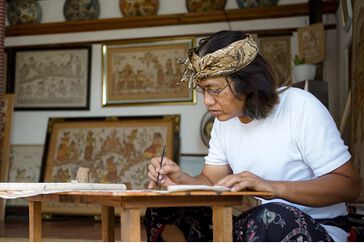Kamasan Paintings
To create a new page, enter a unique page name below.
If a page with that name already exists, you will be sent to a form to edit that page.
For existing pages ... see category Kamasan Paintings.
Fill in the form with the details of your image and save the page.
Kamasan Paintings
The village of Kamasan in the kingdom of Klungkung in east Bali became the centre for traditional Balinese painting. Originally, the Kamasan artists served the kings of Gelgel from the 16th century. Kamasan is only about 2 miles (3.2 kilometres) from Gelgel, where the court reigned during Bali’s golden age. The importance of the Ramayana is also seen in the way Balinese temples are adorned. Traditional cloth paintings were made for hanging on temple eaves, and the walls of temples and shrines were painted with scenes from the story. In Kamasan in the southeastern province of Klungkung, cloth paintings were also given as gifts by the king to other rulers, during the 19th century. Paintings are still found today in this area and the cloth paintings from Kamasan in particular, have enjoyed a revival in recent times. The unique wayang style of painting was Bali’s only form of pictorial representation until the 20th century when the Western artists arrived in central Bali and influenced artists to paint realistic scenes of everyday life. Both styles still exist.
Subject-matter
The subject-matter tends to come from the Ramayana and Mahabarata epic stories, frequently battle scenes and especially the story of Rama, Sita and Rawana. They are like picture books, which are read and examined closely, and no part of the ‘canvas’ is left empty. There are gods, demons, birds, flames, bushes, trees and mythical animals.
Sometimes there is writing on the paintings. Time is shown by depicting the same characters at different stages in the story. They can be several meters long and half a meter wide.
The Language of Paintings
Animal heads are usually shown in profile and humans in three-quarters view. Shoulders and chest face the spectator, and legs and feet are pictured from the side, one behind the other as if walking. Noble characters have long thin arms and legs, delicate hands with curved fingers, narrow straight noses and smiling mouths. Coarse characters have large nostrils. Gestures show emotions.
Noble male eyes have the top part of the eye curved and the bottom part a straight line. For females, it is the reverse. The female eye appears demure and shy and very feminine. Demons’ eyes and noses are at a three-quarter angle but the mouth is in profile. Eyebrows are arched for the refined and touch at the top of the nose. The unrefined have two small lines for wrinkles. Demons’ eyebrows end in fangs.
Refined lips are thin and graceful with white, straight teeth. Coarse characters and animals have large mouths and pointed teeth. Demons have fangs. Refined males do not have beards. Moustaches indicate virility and strength. Coarse characters have hair sprouting from their faces. Animals and demons are hairy. The right hand is active, the unclean left is still. Jewelry indicates rank. The gods and nobles wear bangles and bracelets on their arms and ankles and their costumes are decorated with flowers.

Note the tear-drop filler motifs, the trees which indicate and divide people in conversation, the stylized brown rocks at the bottom of the painting, and the lack of background and perspective. The border resembles a carved wooden frame next to an inner red stripe. These are all characteristic of traditional Kamasan style.
Colour
Colour indicates character: the faces of gods and refined alus humans are light brown or beige, while rough kasar characters are brown and red. Size matters. The most powerful, oldest and highest in rank are also the biggest.
More info:
Wikipedia - Kertha Gosa Pavilion
La Salaga - a legend of two cultures
Balinese paintings in the temple


